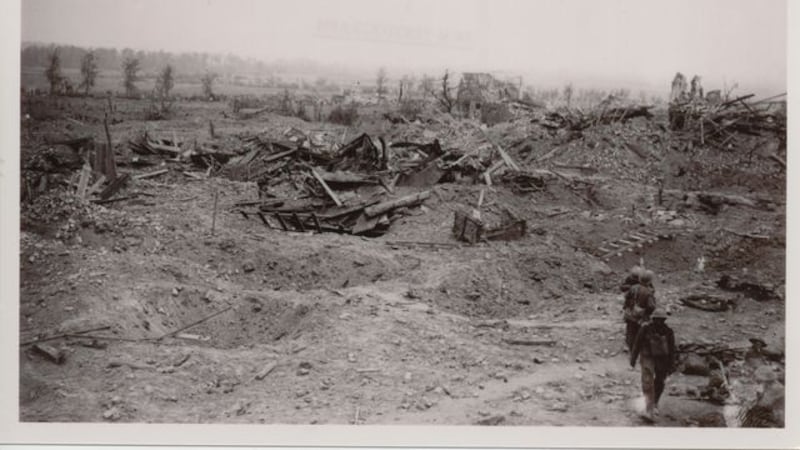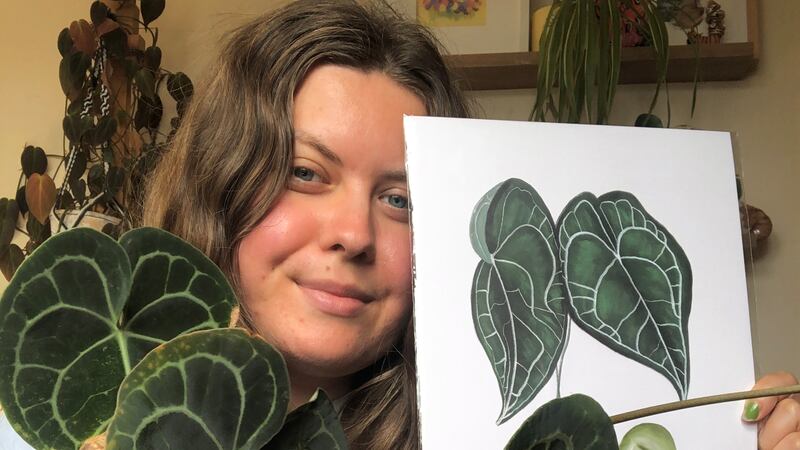THE lack of knowledge among Irish people of their own history fascinates our Flemish guide, historian Philippe Mingels. Many things Irish do: Philippe has become an expert in Irish involvement in the First World War since witnessing the Troubles grimly unfold via Belgian television first aroused his curiosity about us in the 1980s.
He’s therefore aware of the reasons for this gap in our collective consciousness but is none the less despairing of it, the war, as he sees it, being so self-evidently central to the story of Ireland.
History is everywhere in this part of the province of West Flanders, an hour and a half west of Brussels, a place that will be forever known in textbooks as ‘the Ypres Salient’, reference to its strategic significance in the war of a century ago and byword for the ferocious battles fought here.
It is above ground and below, the earth still intermittently yielding bodies and munitions. It is on every hill and in every clump of woodland; in the small church graveyards and in the cemeteries whose rows of uniform little headstones stretch, almost oppressively, as far as the eye can see. It is in every museum and municipal interpretative centre; and in the very fabric of the towns and villages, each one having been rebuilt post-war after every single thing that stood was destroyed and re-destroyed over and over.
But it’s not always necessarily present in the solemn way you might expect. In mid-May in Heuvelland – a small corner of West Flanders whose name translates as ‘hilly land’, though, in Irish terms it’s merely slightly bumpy – there is hawthorn blooming and bright yellow whins.
Despite being 20km from Lille, France’s fourth-largest city, it is resolutely farming country, its villages, around which Irishmen were billeted after fighting at the Somme – Loker, Dranouter, Kemmel, Nieukirke – and where many now lie buried, are sedate and disarmingly pretty places, with good restaurants and lively pubs. (Come now, you can't go to Belgium and not drink beer.)
On our way to Bayernwald, a reconstructed network of German trenches a kilometre from just such a village, Wijtschate, Philippe points through the minibus window to a field that could be straight out of a Kerrygold ad and says: “Hitler was in this area. He even made a painting of that place where the cow is standing – there, on the right; the black one.” The cow looks up as we pass, as if to say; “Who, me?”
Wijtschate – ‘White Sheet’, they called it – was won back from the occupying Germans by the 16th Irish Division and the 36th Ulsters in the Battle of Messines. (West Flanders is Flemish, meaning people here speak a variation of Dutch first and foremost, though, as in much of Belgium overall, they are bilingual. Irish and British soldiers being, well, Irish and British, could, and still can, speak neither Flemish nor French and so anglicised the places whose names they could pronounce in neither language.)
In the village of Messines, where the Island of Ireland Peace Park is located, the then Corporal Hitler also features. Here, the chilly crypt of the Church of St Nicholas, burial place of Adela, countess of Flanders and mother-in-law of Willam the conqueror, served as a field hospital; he was treated here, earlier in the war, after being wounded.
The allied offensive at Messines, a prelude to the more horrendous Battle of Passchendaele, started on June 7 1917; the detonation under the German lines of 19 massive mines, a few of whose eerie craters survive, signalled the off. It was fought a few miles south of the elegant market town of Ypres, more usually known today by its Flemish name, Ieper (which is also easier for Anglophones to pronounce - - ‘Eeper’; they labelled it ‘Wipers’ during the war).
It was here that those two Irish divisions, one unionist, one comprising nationalists who hoped that joining up would help bring about Home Rule, successfully attacked their designated section of the German lines. Their deed, and their dead, will be commemorated in a joint UK-Irish ceremony at the Peace Park on Wednesday (Messines itself, or Mesen as it’s called in Flemish, was ‘liberated’ by New Zealanders, fighting on the Irish/Ulstermen’s flank).
There’ll be particular regard paid to Major Willie Redmond – MP and brother of Irish Parliamentary Party leader John Redmond – and Private John Meeke, the former a Catholic from Wexford fatally wounded on June 7, the latter a Protestant stretcher-bearer from Ballymoney who brought him off the battlefield under heavy fire.
A visit to Redmond’s grave, which uniquely now stands alone in the middle of a field, a farmer ploughing to within a few feet of it as we huddle in tractor-imposed silence and a sudden downpour, underlines the surreality of a visit to Flanders’ First World War battlefield sites, where so many died and yet where life goes irrepressibly on. (“Don’t tell me you’re here for the war too!” a friendly Fleming admonishes in one of Ieper’s packed bars.)
There is so much to take in: the staggering casualty statistics, the ubiquitous memorials and cemeteries. These are frequented by a more or less steady stream of visitors, from all corners of the world.
The numbers have increased since the centenary of the start of the war in 2014; they rise and fall depending on the date; increasingly, they come from Ireland. (And rightly so: journalist Kevin Myers, credited with bringing this part of our history into the light of day, reckons 35,000 Irishmen died in the war, 31,000 of them born on the island, and 250,000 volunteered to fight.)
Crowds at the commemoration at the Menin Gate memorial in Ypres, where the Last Post is played to honour the dead every evening, swell to fill the streets during holidays and notable anniversaries. On this imposing arch, erected on a road along which soldiers of the empire marched to battle, are engraved the names of 55,000 men, 4,000 of them Irish, whose graves are unknown (among them, to my surprise, that of one John Arthur Hallahan, a private in the Australian infantry).
Add these to the 12,000 buried at Tyne Cot, the largest Commonwealth cemetery in the area – in the world, for that matter – and the 36,000 more missing whose names are engraved on its walls. Bear in mind that these are just a fraction of the total killed in Flanders alone and it's almost overwhelming.
But two things stand out most for me: a small, almost inconsequential display consisting of a pair of before-and-after photographs in the excellent war museum in Ieper; and a display of weaponry in the even more impressive museum in what's today called Passendale.
In the first of the photographs, four German soldiers are pictured prior to a raid on an enemy trench; in the second, they are in the target trench, triumphant, with an Allied corpse. It’s not the fact that they are about to, and then just have killed British or, maybe, Irishmen that stays with me, nor is it their smiles in each frame; it is simply their youth.
In Passendale what gets me most isn’t the rows of artillery shells, colourfully coded to handily distinguish calibre and type, like so many rows of giant lethal sweets; it’s a display labelled “Improvised trench clubs”, homemade weapons, weighted and studded, the better to beat a man – or a boy – quietly to death.
FACT FILE
:: Fergal Hallahan travelled to Belgium as a guest of Visit Flanders – visitflanders.co.uk
:: For information of particular interest regarding the Irish at the Battle of Messines see visitflanders.com/en/passchendaele/itineraries/the-irish-in-messines and flandersfields1418.prezly.com/places-to-visit-in-flanders-with-irish-connections
:: Accommodation:
Hotel O, D'Hondtstraat 4, 8900 Ieper – ph +32 57 36 23 30
Peace Village Hostel, Messines – peacevillage.be/en
:: Eating:
Fergal ate at three excellent restaurants:
Den Heksestoel, in Loker – denheksestoel.be
Pacific Eilandje, which is on an island in the moat of the historic town of Ieper (Ypres) – pacificeiland.be
Trilogie, a chic aparthotel and earerie in Kemmel – trilogiekemmel.be/en
He also ate at the cafe of the Hooge Crater Museum, which is well worth a visit
:: Museums:
In Flanders Field Museum, Ieper (Ypres) – inflandersfields.be/en
Memorial Museum Passchendaele 1917, Zonnebeke – passchendaele.be/en
Hooge Crater Museum, Ieper (Ypres) – hoogecrater.com/en
:: Getting there:
A number of Irish tour operators offering tailor-made packages to Ypres and the Salient. All include flights and ground arrangements and transfers:
Joe Walsh Tours – joewalshtours.ie
GTI – gti-ireland.com
Alternatively, you can fly to Brussels and take a train to Ieper (Ypres) from the airport (see b-rail.be for booking) or hire a car. Specialised battlefield tours can be booked locally.



